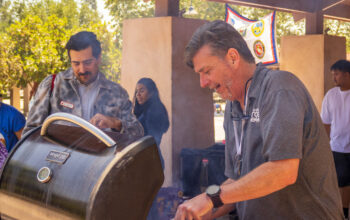Though no one moved from their seats, the audience of the Folk Dance Concert traveled the world through dance on Saturday evening in the Performing Arts building.
It was a full house with more than 300 people in attendance to watch the spectacle showcasing the diverse cultures from around the world in 23 dances.
An audience favorite, India’s Bollywood dance, “Desi Spice” told the story of two lovers by incorporating both India and Western influences. Female lead, Hanna Peterson, entered center stage in a white, glittery sari (cloth that wraps around the waist and shoulder) encircled by dancers, the music resounding in a slow tempo.
The tempo became fast paced as the male lead, Leon Richards, entered the stage and was swiftly rejected by Peterson.
The dance, “Malakas and Maganda,” was inspired by a Philippine tribal myth that depicts the beginning of human kind as a bird finds the first man and woman hidden in a tree, according to the concert program. The production came together after eight weeks of rehearsals, according to Marian Weiser, dance director and professor.
“We had our ups and downs during practice,” said Eric Guardado, 21, who has been dancing at Pierce for four years and participated in the Filipino dance. Throughout the show the audience warmly applauded each act, especially during a particularly difficult move in the Filipino dance. “I fed off the audience so much,” said dance club secretary, Caroline Theodorou.
“Especially in the Philippines dance-there was no set movement, it was all improv.” Bird sounds permeated the theatre as the dancers entered the dimly lit stage, with a group of about six men holding 20-foot bamboo poles.
The poles were interchangeable, serving as the makings of the tree that held the couple to being the foundation of a boat that even included a sail. The crowd went wild when the dancers, holding multicolored sheets, formed a barricade for the couple where dancers would crawl out representing the growing family.
At one point, the male dancers formed a platform with the bamboo poles for the male lead, Leon Richards, to step onto as they raised him. “It felt good; it wasn’t shaky at all,” said Richards, who only wore a cloth garment around the waist.
“I was in the zone.” All the dancers must enroll in dance classes at Pierce and even the production of the show was all done by students enrolled in Theatre 344 and 342, taught by adjunct theatre professor Michael Gend.
The Street Dance club also performed a dance number, representing America during the early 1930s-40s with the Lindy Hop, according to the concert program.
The lively number choreographed by adjunct dance professor Denise Gibson, paired up 27 dancers with the men in all black (sideburns included) and the women in poodle skirts and red checkered sweaters.
The couples flirted on stage in quick, sustained movements with the men swinging the ladies over their heads as “Chantilly Lace” by Jerry Lee Lewis played. “We look good and we have a loving and supportive environment,” said club president Erin Hickey, 22.
“I’m addicted to dance and performing.”
The wardrobe for the show came from the dance costume closet organized by Gibson, who also choreographed the Lindy Hop dance. Weiser, who was present for the eleven-hour rehearsals every Sunday, was excited to see how well the show came together. “I get a high; it’s so exciting even though I know all the dances,” she said.
“Folk dance is the internalization of a culture; that’s what hip-hop is to kids today.” As the curtains closed on the final dance, audience members, some holding bouquets of flowers, lauded the diverse and vibrant showcase.
“It was full of different cultures; the costumes were colorful,” said Civonne Ahal. The show ultimately gave the audience and the dancers a look into the diverse cultures from around the world by intertwining their stories into dance.
“It’s such a gift to me and the audience, and the audience involvement is a gift to the dancers,” said Weiser.



